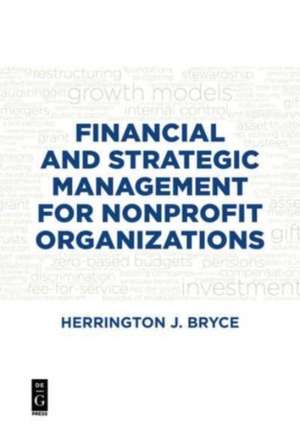Financial and Strategic Management for Nonprofit Organizations, Fourth Edition
Autor Herrington J. Bryceen Limba Engleză Paperback – 23 ian 2017
Herrington J. Bryce was a senior economist at the Urban Institute, a Brookings Economic Policy Fellow, a Fellow at the Institute of Politics at Harvard and a visiting professor in regional economics and planning at the Massachusetts Institute of Technology. He taught micro economic theory and public finance at Clark University in Worcester, Massachusetts, and was director of the program in legal and budget studies at the University College at the University of Maryland. He currently teaches courses at the College of William & Mary in nonprofits but mostly in corporate financial strategy and cost management--heavily reflected in this text. He has published extensively and has served on many state, local and federal government advisory committees. He has a PhD in economics from the Maxwell School at Syracuse University, and a CLU and ChFC from the American College.
Preț: 543.05 lei
Preț vechi: 590.27 lei
-8% Nou
Puncte Express: 815
Preț estimativ în valută:
103.91€ • 108.78$ • 85.98£
103.91€ • 108.78$ • 85.98£
Carte disponibilă
Livrare economică 15-29 martie
Preluare comenzi: 021 569.72.76
Specificații
ISBN-13: 9781501514708
ISBN-10: 1501514709
Pagini: 792
Ilustrații: 47 Schwarz-Weiß- Abbildungen, 56 Schwarz-Weiß- Tabellen
Dimensiuni: 170 x 240 x 43 mm
Greutate: 1.32 kg
Ediția:4th edition
Editura: De Gruyter
ISBN-10: 1501514709
Pagini: 792
Ilustrații: 47 Schwarz-Weiß- Abbildungen, 56 Schwarz-Weiß- Tabellen
Dimensiuni: 170 x 240 x 43 mm
Greutate: 1.32 kg
Ediția:4th edition
Editura: De Gruyter
Notă biografică
Herrington J. Bryce was a senior economist at the Urban Institute, a Brookings Economic Policy Fellow, a Fellow at the Institute of Politics at Harvard and a visiting professor in regional economics and planning at the Massachusetts Institute of Technology. He taught micro economic theory and public finance at Clark University in Worcester, Massachusetts, and was director of the program in legal and budget studies at the University College at the University of Maryland. He currently teaches courses at the College of William & Mary in nonprofits but mostly in corporate financial strategy and cost management. He has published extensively and has served on many state, local and federal government advisory committees. He has a PhD in economics from the Maxwell School at Syracuse University, and a Clu and ChFc from the American College.
Cuprins
Acknowledgements | vii
About the Author | ix
Introduction: Teasing Your Managerial Imagination, Creativity and Resolve | 1
Part I: Why Us
Chapter 1: The Foundations of Nonprofit Management as Asset Management | 9
The Hierarchy | 10
The Need for a Nonprofit Perspective | 11
The Core Tasks of Managing Nonprofit Organizations | 12
Secular Growth of the Nonprofit Sector | 13
A Varied Sector | 14
The Nonprofit as an Asset | 16
Isomorphic Forces and Organizational Identity | 19
The Mission as Contract, Source of Expectation, Confidence and Style | 20
The Public Policy Process as the Principal Action Space | 22
Organization-Specific Opportunities in the Action Space | 23
The Link: Ethics, Effectiveness and Efficiency in Performance | 24
Stewardship | 25
Keeping Track for Evaluation and Direction | 27
Cost as a Driver and as Object of Efficiency | 30
Insufficiency of Contributions | 31
Collaboration | 38
Social Entrepreneurship | 39
Disclosures as Functional Tools | 42
Disclosure as a Management Philosophy or Attitude | 43
The Role of the State | 44
Conflict of Interest and Transactions with Related Parties | 45
Nonprofits as Tax Payers and the Value of Exemption | 45
Summary and Preview | 47
Postscript to Perspectives | 48
Footnotes | 49
Chapter 2: Managing the Corporation, Its Powers, and Exemption | 51
The Nonprofit Corporation: Its Creation, Powers and Prohibitions on
Management | 53
Specific Powers of the Nonprofit Corporation | 54
Specific Prohibitions | 56
How Does the Nonprofit Corporation Differ from a For-Profit Corporation | 58
Financial Advantages and Disadvantages of Exemption | 60
The Tax-Exempt Status: Its Privileges, Prohibitions, Responsibilities | 62
How is the Tax-Exempt Status Acquired First at the Federal Level | 64
How is Tax-Exempt Status Acquired on the State and Local Levels | 69
Factors That Threaten the Loss of Tax-Exempt Status Under 501(C)(3) | 74
Carrying Out a Dissolution | 81
Summary and Preview | 83
Footnotes | 83
Chapter 3: Managing the Nonprofit as a Public Corporation | 85
Forming the Publicly Supported Organization | 85
The Basic Requirements of 501(c)(3)s | 86
Privileges of Public Organizations | 86
The Public Charities: Section 509(a)(1) Organizations | 87
Proof of Public Support: 509(a)(1) | 88
Calculation of Public Financial Support: 509(a)(1) | 90
The Effect of Large Contributions on Public Support | 91
Unusually Large Gifts and Grants | 91
IRS Certification of Organization's Tax-Exempt Status | 92
Fee-For-Service Organizations: 509(A)(2) Organizations | 93
Diversification and Preservation of Tax-Exempt Status | 94
Comparison if 509(A)(1) and (A)(2) Organizations | 96
Category One: Subordinate Corporations | 97
Category Two: Closely Cooperating Affiliates | 99
Summary and Preview | 102
Chapter 4: Managing the Nonprofit as a Private Corporation | 103
The Private Foundation-What It Is | 103
The 501(C)(3) That Is Not Private | 104
The Performance-Based Group | 105
The Formula-Based Group | 106
Private Nonoperating Foundations | 106
Restrictions on Expenditures, Economic Transactions, and Investment | 107
Disqualified Persons | 107
Private Operating Foundations | 113
The Income Test | 113
Asset, Endowment, and Support Tests | 114
Soliciting Private and Community Foundations | 114
Private Foundations | 115
Community Foundations | 116
The Affiliated or Supporting Organizations | 117
The Donor Advised Fund | 117
Private Foundations, Public Foundations, and Charitable Organizations In
Canada | 118
Summary and Preview | 119
Chapter 5: Managing the Nonprofit as Instrument of Groups, Business, and
Politics | 121
Powers of Associations | 122
Associations of Individuals | 122
Civic Leagues and Welfare Organizations | 124
Agricultural Associations | 125
Business Associations | 126
Common Interest of Business Associations | 126
Non-deductibility of Business Lobbying Expenses | 127
Examples of Missions of Business Associations | 127
PACs, SUPERPACs, and Political Organizations including Parties and
Committees | 129
Federal Disclosures by Section 527 Organizations | 131
Social Clubs | 132
Fraternal Associations | 132
Cooperatives | 133
Religion | 134
Veterans | 134
Associations of Organizations | 135
Federations | 135
Affiliations | 136
Groups | 137
The Lodge System | 138
Holding Companies | 138
Common Trusts or Charitable Risk Pools | 139
Membership Powers, Duties, and Liabilities | 139
Stocks as Evidence of Membership | 140
Termination of Membership | 141
Political Involvement of Nonprofit Organizations | 141
Advantage of 501(c)(4) as a Political Vehicle | 142
State Example of Trying to Reign-in the 501(c)(4) | 142
The Feds and 501(c)(4) | 143
Citizens United v. Federal Election Commission as Decided
January 21, 2010 | 144
Non-partisan civic related actions of 501(c)(3) | 147
Summary and Preview | 149
Footnotes | 149
Chapter 6: The Governing Body: Trustees and Directors | 151
Public Interest in the Boards of Nonprofits | 152
A Functioning Board I | 154
A Functioning Board II | 155
Size and Composition of the Board | 156
Independent Members of the Board | 157
Public Officials as Trustees | 158
Organization of The Board into Committees | 158
Interlocking Directorates | 160
Term of Service on The Board | 161
Qualification and Removal of Trustees | 161
Transactions and Trustees | 163
Prohibition by Trustee Classification | 164
Dealing with Possibilities of Conflicts of Interests | 165
States and Trustee Conflict of Interest | 165
A Five-Part Conflict of Interest Policy | 166
Three General Standards of Action of Trustees | 169
Emergency and Appointive Powers of Trustees | 172
Instituting Procedures for Complaints and Corruption | 173
Duty of Organizations to Trustees and Their Rights | 174
Economic Transactions and The Trustees | 175
Bankruptcy and The Trustees | 177
Limitations on Trustee Indemnification | 184
Annual Disclosures of Involvement of Current and Past Trustees and Senior
Management | 185
Summary and Preview | 188
Footnotes | 188
Part II: We Need to Raise Money
Chapter 7: Stimulating Gifts and Contributions: Crafting The Appeal | 191
Individual and Corporate Motives for Giving | 192
Why People Give: New Findings | 194
Why Corporations Give | 198
Why Corporations May Say No | 199
Dangers in Receiving Gifts | 202
Type of Gift and Precaution | 202
Government Promotion of Giving | 204
Payroll Deduction | 204
Tax Deduction and Credit | 204
The Importance of Tax Deductibility of Contributions | 205
Tax Deductibility: Three Cases | 206
Required Characteristics of a Tax-Deductible Gift | 207
Borrowing to Make A Donation | 216
Problems of Accepting Gifts Subject to Debt | 216
Value of Gifts of Present Interests | 218
Gifts of Stocks: Perspectives of Donor And Donee | 222
Reporting Requirements and IRS Vigilance | 225
Limits On Giving | 225
Problems and Strategies of Large Gifts | 228
Mix Strategies | 231
Soliciting Disclosure: Charitable Fundraising 501(C)(3) | 232
Summary and Preview | 233
Footnotes | 233
Chapter 8: Deferred Giving: The Risk/Reward and Virtue of Patience | 237
The Uses of Trusts: Deferred, Extended Benefits, and Cash Flow | 238
Trusts as Charitable Organizations | 239
The Law and The Management of Trust Funds | 240
The Performance of Charitable Remainder Annuity Trusts | 243
Types of Charitable Remainder Trusts | 244
Charitable Lead Trusts | 247
Examples of The Application of Trust Concepts | 249
An Advanced Application of A Remainder Unitrust | 252
An Advanced Application of a Charitable Lead Trust | 252
The Uses of Wills: Gifts Deferred Until Death | 253
Life Insurance: Magnifying The Value of Small Gifts | 257
Death and the Collection of Gift | 258
Ownership | 258
Form of Gift | 259
Types of Policies | 261
Comparing Characteristics of Contracts | 263
Role of Insurance In Fund-Raising Strategy | 264
Annuities: Providing Income Flows | 267
Steps for Determining Deferred Giving Instruments | 269
Endowments: Perpetuating a Gift | 269
The Law and The Investment of Endowment and Other Institutional
Funds | 273
Four Essential Steps For An Endowment | 275
Valuation of Future Gifts | 276
Summary and Preview | 281
Footnotes | 282
Chapter 9: Entrepreneurial Revenues Generated by Mission | 283
What Is Business Income | 283
Sources of Business Income Opportunities | 284
Compatibility of Charity and Profits | 285
Now That You Know the Organization Can, Should It and How? | 294
How Will the Investment Affect the Tax-Exempt Status? | 294
How Suitable Is the Level of Entrepreneurship for This Organization? | 296
How to Acquire a Business | 298
Should the Business Be Related or Unrelated? | 299
Should the Business Be Separately Incorporated? | 299
Where Does the Money Come From To Acquire The Business? | 300
Is the Business Profitable? | 300
Is Profitability Enough? | 301
Can the Business Be Made Profitable? | 302
What Will the Investment Cost? | 304
From A Financial Perspective, Is the Investment Worth It? | 304
Do the Benefits Exceed the Costs? | 305
When Will The Organization Recapture Its Investment? | 307
What Are the Risks? | 307
What Will It Take to Break Even? | 308
What Can Be Done with The Earnings of The Business? | 309
How Will Entry into the Business Be Made? | 309
Is the Business Understood and Reflected in A Viable Plan Including When to
Exit, Shift Gears, and How to Operate? | 310
Is A Collaboration Appropriate for This Venture or Organization? | 311
Is There Competition? Is It Fair? | 311
What Do the Trustees Think of the Plan? | 312
Ethical Dilemma of Business Competition | 313
Summary and Preview | 314
Footnotes | 315
Chapter 10: Entrepreneurial Revenues Unrelated to Mission | 317
Definition of Related and Unrelated Nonprofit Businesses | 319
Excess Profits: A Distinction Between Related and Unrelated Income | 322
Integration of Business Operations into A Conglomerate Structure | 322
The Organization of an Unrelated Business | 325
Benefits, Consequences, and Opportunities of Unrelated Businesses | 326
Consequences of Unrelated Businesses | 327
Benign Origins of Unrelated Businesses | 328
Unrelated Business for Cost-Sharing Purposes | 329
Tax Treatment of Different Types of Business Income | 329
Sources of Unrelated Business Income: A Simplified View | 343
Ten Questions to Judge Whether Business Will Be Unrelated | 344
The Federal Tax | 344
Other Costs of Unrelated Business Income | 347
Key Points on Entrepreneurial Income in Nonprofits | 347
Summary and Preview | 348
Part III: Marketing the Good and Bad News: Convincing
Chapter 11: Marketing and Solicitation Guidance | 351
Solicitation | 351
The Solicitors for Charitable Purposes (Fundraisers) | 352
Federal Solicitation Rules for Charitable Purposes | 355
The Choice of Fundraising Contractor | 355
Non-Charitable Solicitation | 358
Commercial Marketing | 360
Choosing an Object of Marketing | 365
Choosing A Target | 366
Targeting by Income Levels | 367
Specific Risk Exposures of Nonprofits In Commercial Marketing | 369
The Importance of A Trustee Policy | 370
Charitable Solicitation: Massachusetts And Others | 371
Summary and Preview | 374
Footnotes | 375
Chapter 12: Restoring Trust: A Use of Relationship Marketing | 377
First, What Is Trust? | 377
Contracting | 378
The Distinction between Unrestricted and Restricted Donations as Trust
Transactions | 380
A Conundrum and Constraints On Restoring The Public Trust | 385
A Guide to Managing The Public Trust | 388
Summary | 390
Footnotes | 390
Part IV: The Inescapable Risks and Costs
Chapter 13: Corruption | 395
Types and Effects of Corruption in Nonprofit Organizations | 395
Sources and Opportunities for Corruption | 398
Managing the Risks of Corruption and Fraud | 399
Controls: A Transaction Approach | 400
Intelligence: Information and The Protection of Sources and Records | 403
The Internal Audit and Required Disclosures | 404
Summary and Review | 406
Footnotes | 406
Chapter 14: Negligence, Discrimination, Harassment and Abuse | 409
The Basics of Risk Management | 409
A Simplified Approach to Risk Identification and Intervention | 410
Types of Risks | 412
Protecting Against Liability of Independent Contractors | 414
Coverage: Shields Can Be Penetrated | 420
Discrimination Against the Disabled | 430
Summary and Preview | 433
Chapter 15: Compensation and Employee Benefits | 435
Excess Executive Compensation | 435
Key Employees and Reasonable Compensation | 437
Accidental Death and Dismemberment | 446
The Affordable Care Act and Nonprofits | 447
The Traditional Medical and Hospitalization Insurance Plans | 448
Health Maintenance Organizations | 451
COBRA | 453
Pensions | 453
Rabbi Trust | 460
SIMPLE Ira or 401(K) | 460
Cafeteria Plans | 464
Profit-Sharing Plan | 464
Fringe Benefits | 465
Discrimination in Medical Benefits | 470
To Discriminate or Not | 471
Ten Steps to Setting Up the Benefit Package | 472
Independent Contractors and Social Security | 472
Summary and Preview | 474
Chapter 16: Budgets: Controlling Costs and Sending a Message | 475
The Budget as A Management Tool | 475
The Budget as A Sum Of Parts | 476
The Budget as Contemporary History | 477
Capital and Operating Budgets | 478
Budgets as Baseline | 478
Budgets as Fiction | 478
Principles Underlying Budgets | 479
Zero-Based Budgeting and PPBS | 479
Efficiency: Costs and Support | 480
The Importance of Distinguishing Between Cash (Expenditures) and Costs In
Budgeting | 480
Classification and Treatment of Costs in Budgeting | 481
Unallowable Indirect Costs | 486
Capital, Operating, and Replacement Costs and Expenses | 491
Costs and Responsibility Centers | 493
Ten Steps to Cost Budgeting | 495
How to Estimate Costs Simply | 499
Key to Controlling Costs | 499
Leasing as A Fixed-Cost Strategy | 500
Outsourcing as A Cost Strategy | 501
Support and Revenues | 502
Allocating Dollars Across Programs | 503
Permanent Revenues and Fixed Costs | 505
Forecasting | 506
Illustration: Costs and Revenues and Their Relationship to the Budget | 507
Budgeting by Scenario | 510
Discretionary Forecasting and Budgeting | 512
Budget Formats: Form Follows Function | 512
Combinations of Program and Item Budgets | 512
Variances | 515
A Recommended Format for Using the Budget As a Control Tool | 518
A Budget Format for The Board | 521
Summary and Preview | 523
Part V: Financial Performance Future and Prolog
Chapter 17: The Financial Performance and the Strength to Continue | 527
Financial Statements as An Aid to Management | 527
The Balance Sheet or Statement of Financial Position | 528
Accounting for Financial Assets and Liabilities on the Balance Sheet | 534
Statement of Support, Revenues, and Expenses or Statement of
Activities | 535
Comparative Statement of Activities | 538
Statement of Changes In Financial Position | 539
Statement of Cash Flow | 543
Funds: A Managerial Accounting Perspective | 545
Illustration of Managerial Use of Financial Statements | 553
How Much Do Financial Statements Tell? | 566
Summary and Preview | 567
Chapter 18: Evaluating Old Targets and Setting New Ones | 569
Questions for Evaluating Old Targets | 570
Risks Inherent in Target Setting and in Target Achievement | 572
The Treasurer's Report as A Source of Intelligence for Setting Financial
Targets | 574
Cash Management and Investment Strategies: Increasing Cash | 576
Borrowing as A Source of Cash | 578
Short-Term Borrowing | 579
Uses of Cash | 584
Summary and Preview | 612
Part VI: Steady Growth
Chapter 19: Growth: The Search for Opportunities and Alliances | 615
Issues to Guide Growth Considerations | 615
Collaboration | 622
Summary and Preview | 638
Footnotes | 638
Chapter 20: Organic Growth by Program Expansion | 639
Strategic Stations for Program Choice | 639
Strategic Options: Profits Versus Mission | 644
Summary And Review | 668
Chapter 21: Growth by Accretive Action and Dissolution | 669
The Importance of Structure | 669
A Holding Company and Its System | 670
Principles behind Corporate Organizations | 671
Pitfalls of Reorganizing a Nonprofit in any Way | 673
Antitrust | 673
States in Reorganizations | 674
Types of Reorganization | 680
Summary and Conclusion | 692
Appendix A | 695
Appendix B: National Taxonomy of Tax-Exempt Entities -Core Codes | 697
Appendix C: Mathematics of Lobbying Expenditures | 707
Lobbying expenditures limits | 707
Appendix D: Sample Conflicts of Interest Policy (Revised 5/22/97) | 709
Article I: Purpose | 709
Article II: Definitions | 709
Article III: Procedures | 710
Article IV: Records Of Proceedings | 711
Article V: Compensation Committees | 711
Article VI: Annual Statements | 711
Article VII: Periodic Reviews | 712
Article VIII: Use of Outside Experts | 712
Appendix E: New York State | 713
Conflict of Interest Policy: Minimum Statutory Requirements | 714
Appendix F: Breakeven Point | 719
Appendix G: Key Concepts in Federal Contracting and Glossary of Common
Financial Terms Found in Such Contracts | 721
Key Concepts in Federal Contract Management | 721
Appendix H: Risks of Cost Denial | 729
Index | 732
About the Author | ix
Introduction: Teasing Your Managerial Imagination, Creativity and Resolve | 1
Part I: Why Us
Chapter 1: The Foundations of Nonprofit Management as Asset Management | 9
The Hierarchy | 10
The Need for a Nonprofit Perspective | 11
The Core Tasks of Managing Nonprofit Organizations | 12
Secular Growth of the Nonprofit Sector | 13
A Varied Sector | 14
The Nonprofit as an Asset | 16
Isomorphic Forces and Organizational Identity | 19
The Mission as Contract, Source of Expectation, Confidence and Style | 20
The Public Policy Process as the Principal Action Space | 22
Organization-Specific Opportunities in the Action Space | 23
The Link: Ethics, Effectiveness and Efficiency in Performance | 24
Stewardship | 25
Keeping Track for Evaluation and Direction | 27
Cost as a Driver and as Object of Efficiency | 30
Insufficiency of Contributions | 31
Collaboration | 38
Social Entrepreneurship | 39
Disclosures as Functional Tools | 42
Disclosure as a Management Philosophy or Attitude | 43
The Role of the State | 44
Conflict of Interest and Transactions with Related Parties | 45
Nonprofits as Tax Payers and the Value of Exemption | 45
Summary and Preview | 47
Postscript to Perspectives | 48
Footnotes | 49
Chapter 2: Managing the Corporation, Its Powers, and Exemption | 51
The Nonprofit Corporation: Its Creation, Powers and Prohibitions on
Management | 53
Specific Powers of the Nonprofit Corporation | 54
Specific Prohibitions | 56
How Does the Nonprofit Corporation Differ from a For-Profit Corporation | 58
Financial Advantages and Disadvantages of Exemption | 60
The Tax-Exempt Status: Its Privileges, Prohibitions, Responsibilities | 62
How is the Tax-Exempt Status Acquired First at the Federal Level | 64
How is Tax-Exempt Status Acquired on the State and Local Levels | 69
Factors That Threaten the Loss of Tax-Exempt Status Under 501(C)(3) | 74
Carrying Out a Dissolution | 81
Summary and Preview | 83
Footnotes | 83
Chapter 3: Managing the Nonprofit as a Public Corporation | 85
Forming the Publicly Supported Organization | 85
The Basic Requirements of 501(c)(3)s | 86
Privileges of Public Organizations | 86
The Public Charities: Section 509(a)(1) Organizations | 87
Proof of Public Support: 509(a)(1) | 88
Calculation of Public Financial Support: 509(a)(1) | 90
The Effect of Large Contributions on Public Support | 91
Unusually Large Gifts and Grants | 91
IRS Certification of Organization's Tax-Exempt Status | 92
Fee-For-Service Organizations: 509(A)(2) Organizations | 93
Diversification and Preservation of Tax-Exempt Status | 94
Comparison if 509(A)(1) and (A)(2) Organizations | 96
Category One: Subordinate Corporations | 97
Category Two: Closely Cooperating Affiliates | 99
Summary and Preview | 102
Chapter 4: Managing the Nonprofit as a Private Corporation | 103
The Private Foundation-What It Is | 103
The 501(C)(3) That Is Not Private | 104
The Performance-Based Group | 105
The Formula-Based Group | 106
Private Nonoperating Foundations | 106
Restrictions on Expenditures, Economic Transactions, and Investment | 107
Disqualified Persons | 107
Private Operating Foundations | 113
The Income Test | 113
Asset, Endowment, and Support Tests | 114
Soliciting Private and Community Foundations | 114
Private Foundations | 115
Community Foundations | 116
The Affiliated or Supporting Organizations | 117
The Donor Advised Fund | 117
Private Foundations, Public Foundations, and Charitable Organizations In
Canada | 118
Summary and Preview | 119
Chapter 5: Managing the Nonprofit as Instrument of Groups, Business, and
Politics | 121
Powers of Associations | 122
Associations of Individuals | 122
Civic Leagues and Welfare Organizations | 124
Agricultural Associations | 125
Business Associations | 126
Common Interest of Business Associations | 126
Non-deductibility of Business Lobbying Expenses | 127
Examples of Missions of Business Associations | 127
PACs, SUPERPACs, and Political Organizations including Parties and
Committees | 129
Federal Disclosures by Section 527 Organizations | 131
Social Clubs | 132
Fraternal Associations | 132
Cooperatives | 133
Religion | 134
Veterans | 134
Associations of Organizations | 135
Federations | 135
Affiliations | 136
Groups | 137
The Lodge System | 138
Holding Companies | 138
Common Trusts or Charitable Risk Pools | 139
Membership Powers, Duties, and Liabilities | 139
Stocks as Evidence of Membership | 140
Termination of Membership | 141
Political Involvement of Nonprofit Organizations | 141
Advantage of 501(c)(4) as a Political Vehicle | 142
State Example of Trying to Reign-in the 501(c)(4) | 142
The Feds and 501(c)(4) | 143
Citizens United v. Federal Election Commission as Decided
January 21, 2010 | 144
Non-partisan civic related actions of 501(c)(3) | 147
Summary and Preview | 149
Footnotes | 149
Chapter 6: The Governing Body: Trustees and Directors | 151
Public Interest in the Boards of Nonprofits | 152
A Functioning Board I | 154
A Functioning Board II | 155
Size and Composition of the Board | 156
Independent Members of the Board | 157
Public Officials as Trustees | 158
Organization of The Board into Committees | 158
Interlocking Directorates | 160
Term of Service on The Board | 161
Qualification and Removal of Trustees | 161
Transactions and Trustees | 163
Prohibition by Trustee Classification | 164
Dealing with Possibilities of Conflicts of Interests | 165
States and Trustee Conflict of Interest | 165
A Five-Part Conflict of Interest Policy | 166
Three General Standards of Action of Trustees | 169
Emergency and Appointive Powers of Trustees | 172
Instituting Procedures for Complaints and Corruption | 173
Duty of Organizations to Trustees and Their Rights | 174
Economic Transactions and The Trustees | 175
Bankruptcy and The Trustees | 177
Limitations on Trustee Indemnification | 184
Annual Disclosures of Involvement of Current and Past Trustees and Senior
Management | 185
Summary and Preview | 188
Footnotes | 188
Part II: We Need to Raise Money
Chapter 7: Stimulating Gifts and Contributions: Crafting The Appeal | 191
Individual and Corporate Motives for Giving | 192
Why People Give: New Findings | 194
Why Corporations Give | 198
Why Corporations May Say No | 199
Dangers in Receiving Gifts | 202
Type of Gift and Precaution | 202
Government Promotion of Giving | 204
Payroll Deduction | 204
Tax Deduction and Credit | 204
The Importance of Tax Deductibility of Contributions | 205
Tax Deductibility: Three Cases | 206
Required Characteristics of a Tax-Deductible Gift | 207
Borrowing to Make A Donation | 216
Problems of Accepting Gifts Subject to Debt | 216
Value of Gifts of Present Interests | 218
Gifts of Stocks: Perspectives of Donor And Donee | 222
Reporting Requirements and IRS Vigilance | 225
Limits On Giving | 225
Problems and Strategies of Large Gifts | 228
Mix Strategies | 231
Soliciting Disclosure: Charitable Fundraising 501(C)(3) | 232
Summary and Preview | 233
Footnotes | 233
Chapter 8: Deferred Giving: The Risk/Reward and Virtue of Patience | 237
The Uses of Trusts: Deferred, Extended Benefits, and Cash Flow | 238
Trusts as Charitable Organizations | 239
The Law and The Management of Trust Funds | 240
The Performance of Charitable Remainder Annuity Trusts | 243
Types of Charitable Remainder Trusts | 244
Charitable Lead Trusts | 247
Examples of The Application of Trust Concepts | 249
An Advanced Application of A Remainder Unitrust | 252
An Advanced Application of a Charitable Lead Trust | 252
The Uses of Wills: Gifts Deferred Until Death | 253
Life Insurance: Magnifying The Value of Small Gifts | 257
Death and the Collection of Gift | 258
Ownership | 258
Form of Gift | 259
Types of Policies | 261
Comparing Characteristics of Contracts | 263
Role of Insurance In Fund-Raising Strategy | 264
Annuities: Providing Income Flows | 267
Steps for Determining Deferred Giving Instruments | 269
Endowments: Perpetuating a Gift | 269
The Law and The Investment of Endowment and Other Institutional
Funds | 273
Four Essential Steps For An Endowment | 275
Valuation of Future Gifts | 276
Summary and Preview | 281
Footnotes | 282
Chapter 9: Entrepreneurial Revenues Generated by Mission | 283
What Is Business Income | 283
Sources of Business Income Opportunities | 284
Compatibility of Charity and Profits | 285
Now That You Know the Organization Can, Should It and How? | 294
How Will the Investment Affect the Tax-Exempt Status? | 294
How Suitable Is the Level of Entrepreneurship for This Organization? | 296
How to Acquire a Business | 298
Should the Business Be Related or Unrelated? | 299
Should the Business Be Separately Incorporated? | 299
Where Does the Money Come From To Acquire The Business? | 300
Is the Business Profitable? | 300
Is Profitability Enough? | 301
Can the Business Be Made Profitable? | 302
What Will the Investment Cost? | 304
From A Financial Perspective, Is the Investment Worth It? | 304
Do the Benefits Exceed the Costs? | 305
When Will The Organization Recapture Its Investment? | 307
What Are the Risks? | 307
What Will It Take to Break Even? | 308
What Can Be Done with The Earnings of The Business? | 309
How Will Entry into the Business Be Made? | 309
Is the Business Understood and Reflected in A Viable Plan Including When to
Exit, Shift Gears, and How to Operate? | 310
Is A Collaboration Appropriate for This Venture or Organization? | 311
Is There Competition? Is It Fair? | 311
What Do the Trustees Think of the Plan? | 312
Ethical Dilemma of Business Competition | 313
Summary and Preview | 314
Footnotes | 315
Chapter 10: Entrepreneurial Revenues Unrelated to Mission | 317
Definition of Related and Unrelated Nonprofit Businesses | 319
Excess Profits: A Distinction Between Related and Unrelated Income | 322
Integration of Business Operations into A Conglomerate Structure | 322
The Organization of an Unrelated Business | 325
Benefits, Consequences, and Opportunities of Unrelated Businesses | 326
Consequences of Unrelated Businesses | 327
Benign Origins of Unrelated Businesses | 328
Unrelated Business for Cost-Sharing Purposes | 329
Tax Treatment of Different Types of Business Income | 329
Sources of Unrelated Business Income: A Simplified View | 343
Ten Questions to Judge Whether Business Will Be Unrelated | 344
The Federal Tax | 344
Other Costs of Unrelated Business Income | 347
Key Points on Entrepreneurial Income in Nonprofits | 347
Summary and Preview | 348
Part III: Marketing the Good and Bad News: Convincing
Chapter 11: Marketing and Solicitation Guidance | 351
Solicitation | 351
The Solicitors for Charitable Purposes (Fundraisers) | 352
Federal Solicitation Rules for Charitable Purposes | 355
The Choice of Fundraising Contractor | 355
Non-Charitable Solicitation | 358
Commercial Marketing | 360
Choosing an Object of Marketing | 365
Choosing A Target | 366
Targeting by Income Levels | 367
Specific Risk Exposures of Nonprofits In Commercial Marketing | 369
The Importance of A Trustee Policy | 370
Charitable Solicitation: Massachusetts And Others | 371
Summary and Preview | 374
Footnotes | 375
Chapter 12: Restoring Trust: A Use of Relationship Marketing | 377
First, What Is Trust? | 377
Contracting | 378
The Distinction between Unrestricted and Restricted Donations as Trust
Transactions | 380
A Conundrum and Constraints On Restoring The Public Trust | 385
A Guide to Managing The Public Trust | 388
Summary | 390
Footnotes | 390
Part IV: The Inescapable Risks and Costs
Chapter 13: Corruption | 395
Types and Effects of Corruption in Nonprofit Organizations | 395
Sources and Opportunities for Corruption | 398
Managing the Risks of Corruption and Fraud | 399
Controls: A Transaction Approach | 400
Intelligence: Information and The Protection of Sources and Records | 403
The Internal Audit and Required Disclosures | 404
Summary and Review | 406
Footnotes | 406
Chapter 14: Negligence, Discrimination, Harassment and Abuse | 409
The Basics of Risk Management | 409
A Simplified Approach to Risk Identification and Intervention | 410
Types of Risks | 412
Protecting Against Liability of Independent Contractors | 414
Coverage: Shields Can Be Penetrated | 420
Discrimination Against the Disabled | 430
Summary and Preview | 433
Chapter 15: Compensation and Employee Benefits | 435
Excess Executive Compensation | 435
Key Employees and Reasonable Compensation | 437
Accidental Death and Dismemberment | 446
The Affordable Care Act and Nonprofits | 447
The Traditional Medical and Hospitalization Insurance Plans | 448
Health Maintenance Organizations | 451
COBRA | 453
Pensions | 453
Rabbi Trust | 460
SIMPLE Ira or 401(K) | 460
Cafeteria Plans | 464
Profit-Sharing Plan | 464
Fringe Benefits | 465
Discrimination in Medical Benefits | 470
To Discriminate or Not | 471
Ten Steps to Setting Up the Benefit Package | 472
Independent Contractors and Social Security | 472
Summary and Preview | 474
Chapter 16: Budgets: Controlling Costs and Sending a Message | 475
The Budget as A Management Tool | 475
The Budget as A Sum Of Parts | 476
The Budget as Contemporary History | 477
Capital and Operating Budgets | 478
Budgets as Baseline | 478
Budgets as Fiction | 478
Principles Underlying Budgets | 479
Zero-Based Budgeting and PPBS | 479
Efficiency: Costs and Support | 480
The Importance of Distinguishing Between Cash (Expenditures) and Costs In
Budgeting | 480
Classification and Treatment of Costs in Budgeting | 481
Unallowable Indirect Costs | 486
Capital, Operating, and Replacement Costs and Expenses | 491
Costs and Responsibility Centers | 493
Ten Steps to Cost Budgeting | 495
How to Estimate Costs Simply | 499
Key to Controlling Costs | 499
Leasing as A Fixed-Cost Strategy | 500
Outsourcing as A Cost Strategy | 501
Support and Revenues | 502
Allocating Dollars Across Programs | 503
Permanent Revenues and Fixed Costs | 505
Forecasting | 506
Illustration: Costs and Revenues and Their Relationship to the Budget | 507
Budgeting by Scenario | 510
Discretionary Forecasting and Budgeting | 512
Budget Formats: Form Follows Function | 512
Combinations of Program and Item Budgets | 512
Variances | 515
A Recommended Format for Using the Budget As a Control Tool | 518
A Budget Format for The Board | 521
Summary and Preview | 523
Part V: Financial Performance Future and Prolog
Chapter 17: The Financial Performance and the Strength to Continue | 527
Financial Statements as An Aid to Management | 527
The Balance Sheet or Statement of Financial Position | 528
Accounting for Financial Assets and Liabilities on the Balance Sheet | 534
Statement of Support, Revenues, and Expenses or Statement of
Activities | 535
Comparative Statement of Activities | 538
Statement of Changes In Financial Position | 539
Statement of Cash Flow | 543
Funds: A Managerial Accounting Perspective | 545
Illustration of Managerial Use of Financial Statements | 553
How Much Do Financial Statements Tell? | 566
Summary and Preview | 567
Chapter 18: Evaluating Old Targets and Setting New Ones | 569
Questions for Evaluating Old Targets | 570
Risks Inherent in Target Setting and in Target Achievement | 572
The Treasurer's Report as A Source of Intelligence for Setting Financial
Targets | 574
Cash Management and Investment Strategies: Increasing Cash | 576
Borrowing as A Source of Cash | 578
Short-Term Borrowing | 579
Uses of Cash | 584
Summary and Preview | 612
Part VI: Steady Growth
Chapter 19: Growth: The Search for Opportunities and Alliances | 615
Issues to Guide Growth Considerations | 615
Collaboration | 622
Summary and Preview | 638
Footnotes | 638
Chapter 20: Organic Growth by Program Expansion | 639
Strategic Stations for Program Choice | 639
Strategic Options: Profits Versus Mission | 644
Summary And Review | 668
Chapter 21: Growth by Accretive Action and Dissolution | 669
The Importance of Structure | 669
A Holding Company and Its System | 670
Principles behind Corporate Organizations | 671
Pitfalls of Reorganizing a Nonprofit in any Way | 673
Antitrust | 673
States in Reorganizations | 674
Types of Reorganization | 680
Summary and Conclusion | 692
Appendix A | 695
Appendix B: National Taxonomy of Tax-Exempt Entities -Core Codes | 697
Appendix C: Mathematics of Lobbying Expenditures | 707
Lobbying expenditures limits | 707
Appendix D: Sample Conflicts of Interest Policy (Revised 5/22/97) | 709
Article I: Purpose | 709
Article II: Definitions | 709
Article III: Procedures | 710
Article IV: Records Of Proceedings | 711
Article V: Compensation Committees | 711
Article VI: Annual Statements | 711
Article VII: Periodic Reviews | 712
Article VIII: Use of Outside Experts | 712
Appendix E: New York State | 713
Conflict of Interest Policy: Minimum Statutory Requirements | 714
Appendix F: Breakeven Point | 719
Appendix G: Key Concepts in Federal Contracting and Glossary of Common
Financial Terms Found in Such Contracts | 721
Key Concepts in Federal Contract Management | 721
Appendix H: Risks of Cost Denial | 729
Index | 732

















